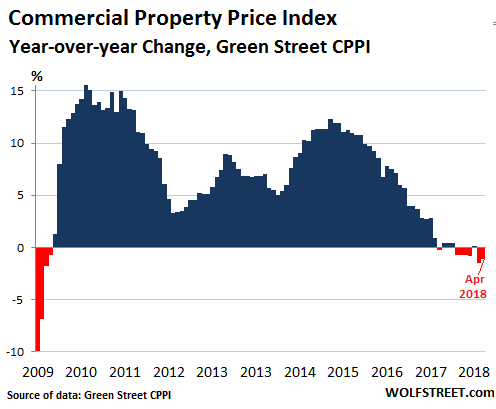Wolf Richter wolfstreet.com, http://www.amazon.com/author/wolfrichter
This is the brick & mortar part of e-commerce.
Commercial real estate prices peaked in August 2017 at 27% above the crazy peak of the prior bubble, according to the Green Street Commercial Property Price Index (CPPI). By April this year, the index was down 1.4% from the peak and by about 1% from April a year ago.
The chart of the year-over-year changes of the CPPI shows the gentle down-trend since September last year. But it hides the turmoil beneath the surface, with the subsector for malls plunging 16% from its peak at the end of 2016 as brick-and-mortar retail is melting down, and with industrial — which includes warehouses, the brick-and-mortar component of e-commerce – soaring 11%:

The industrial segment has been hot around the country, particularly in large urban areas, such as the San Francisco Bay Area, New York-New Jersey, or Seattle, where warehouse capacity is tight amid high demand. And rents for industrial space have been soaring.
So here are some of the dynamics of industrial properties in greater Silicon Valley, based on data provided by the research team at Transwestern, a national commercial real estate firm.
The total inventory of industrial space in greater Silicon Valley inched up to 192 million square feet in the first quarter of 2018. But vacant inventory, offered by landlords directly and by companies that no longer need it and thus try to sublet it, fell to 11.4 million square feet, or to 5.9% of the total, a historic low.
The data includes warehouse, manufacturing, and flex buildings of 20,000 sq. ft. or larger, but excludes data center and showroom buildings. Vacancies among warehouse buildings were only 1.8%, and among manufacturing buildings 1.9%; which means essentially no vacancies. However, flex buildings had vacancies of 10%.
This chart shows greater Silicon Valley’s vacant industrial space in million square feet (red line, left scale), and vacant space as a percent of the total industrial space (blue line, right scale):
![]()
According to Transwestern:
Investment and leasing activity among Silicon Valley tech giants was very robust in the first quarter, as Google continued to buy industrial space in San Jose, and Facebook made its big move into Fremont after signing a notable lease in the previous quarter. In all, tech giants’ activity is keeping momentum in the Silicon Valley industrial market.
Under these conditions of tight supply, robust demand, and few vacancies, landlords can raise rents, and so rents are jumping from historic high to historic high.
In greater Silicon Valley, industrial rents rose 6.7% year-over-year to $1.76 per square foot per month, the 22nd quarterly increase in a row. Rents have doubled since Q2 2011 ($0.87) and are up 50% from the crazy peak in Q2 2008 ($1.17). Note that rents dropped 27% in three years, from Q2 2008 to the low point of the Great Recession Q1 2011 ($0.85):
![]()
In the first quarter, new supply of industrial space was scarce: only 22,000 square feet was added. But more will come on the market, with 1.1 million square feet under construction. Transwestern provides some details:
The much-anticipated McCarthy Ranch in Milpitas will have over 450,000 square feet of warehouse space come online in its first phase early in the second quarter. Other notable developments to hit the market include Intuitive Surgical’s redevelopment of buildings on Kifer Road in Sunnyvale into two, 600,000 square foot buildings, of which 326,000 square feet is slated to complete in the second quarter of 2019.
The chart below shows the total industrial space under construction. Note the collapse of new construction activity to zero as a result of the Great Recession four about three years. The lag between the Great Recession and the shutdown of industrial construction is because projects are planned years ahead of time; those that have been started are generally completed unless the developer collapses, but during the Great Recession, no new projects moved forward from the planning stages:
![]()
Transwestern sees this new construction as adding “some relief to a market that is showing no signs of cooling off.”
These trends in industrial real estate are playing out across the country. So even as many retail properties are getting into serious trouble due to the attack from e-commerce, and some are becoming essentially useless for retail and have to be repurposed or redeveloped into something else, it’s the brick-and-mortar side of e-commerce – lowly warehouses and fulfillment centers – that has become the hottest trend in commercial real estate.